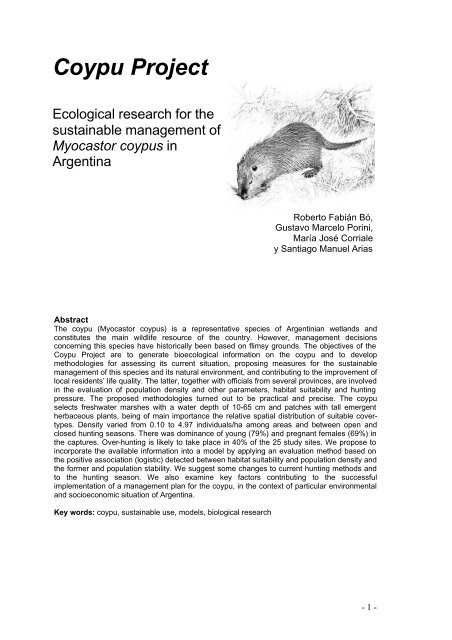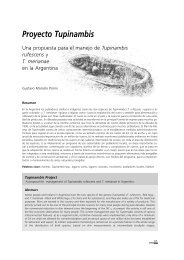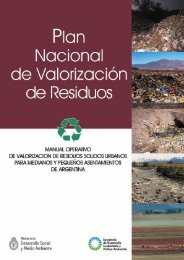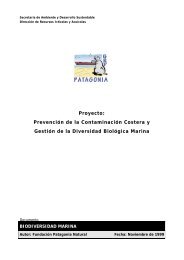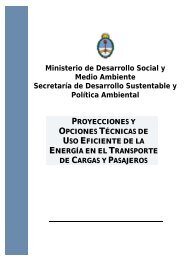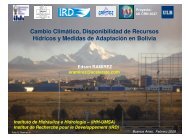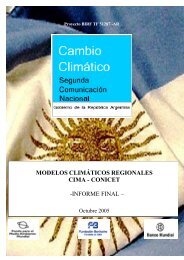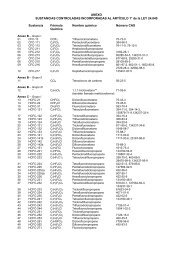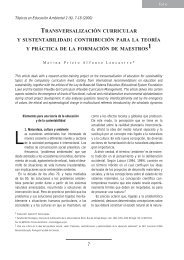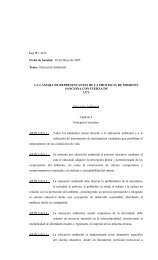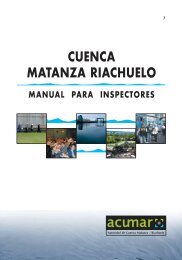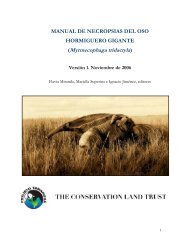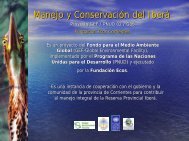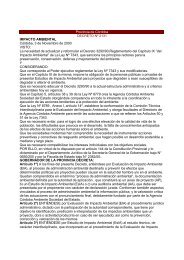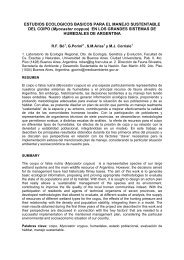Coypu Project - Secretaria de Ambiente y Desarrollo Sustentable
Coypu Project - Secretaria de Ambiente y Desarrollo Sustentable
Coypu Project - Secretaria de Ambiente y Desarrollo Sustentable
You also want an ePaper? Increase the reach of your titles
YUMPU automatically turns print PDFs into web optimized ePapers that Google loves.
<strong>Coypu</strong> <strong>Project</strong>Ecological research for thesustainable management ofMyocastor coypus inArgentinaRoberto Fabián Bó,Gustavo Marcelo Porini,María José Corrialey Santiago Manuel AriasAbstractThe coypu (Myocastor coypus) is a representative species of Argentinian wetlands andconstitutes the main wildlife resource of the country. However, management <strong>de</strong>cisionsconcerning this species have historically been based on flimsy grounds. The objectives of the<strong>Coypu</strong> <strong>Project</strong> are to generate bioecological information on the coypu and to <strong>de</strong>velopmethodologies for assessing its current situation, proposing measures for the sustainablemanagement of this species and its natural environment, and contributing to the improvement oflocal resi<strong>de</strong>nts’ life quality. The latter, together with officials from several provinces, are involvedin the evaluation of population <strong>de</strong>nsity and other parameters, habitat suitability and huntingpressure. The proposed methodologies turned out to be practical and precise. The coypuselects freshwater marshes with a water <strong>de</strong>pth of 10-65 cm and patches with tall emergentherbaceous plants, being of main importance the relative spatial distribution of suitable covertypes.Density varied from 0.10 to 4.97 individuals/ha among areas and between open andclosed hunting seasons. There was dominance of young (79%) and pregnant females (69%) inthe captures. Over-hunting is likely to take place in 40% of the 25 study sites. We propose toincorporate the available information into a mo<strong>de</strong>l by applying an evaluation method based onthe positive association (logistic) <strong>de</strong>tected between habitat suitability and population <strong>de</strong>nsity andthe former and population stability. We suggest some changes to current hunting methods andto the hunting season. We also examine key factors contributing to the successfulimplementation of a management plan for the coypu, in the context of particular environmentaland socioeconomic situation of Argentina.Key words: coypu, sustainable use, mo<strong>de</strong>ls, biological research- 1 -
Management of wild life in ArgentinaIntroductionThe species and its useThe coypu (Myocastor coypus), also calledquiyá or false otter, is a relatively large ro<strong>de</strong>nt(it weights an average of 5 kg), of amphibioushabits, native of large wetland systemscharacteristic of southeastern regions inSouth America (Parera, 2002). This species isone of the most representative and historicallyabundant species of wild fauna in Argentina(Bó et al., in press) due to its herbivorousnature, its relatively high reproductive rate, itstolerance to a wi<strong>de</strong> range of climatic andhydrologic conditions and its high capacity ofdispersion and colonization. This isparticularly true for the subspecies M.c.bonariensis, which inhabits the basins of ourregional large rivers (Paraguay, Paraná,Uruguay and Río <strong>de</strong> la Plata) and the lakesystems of the pampas.The interaction between man and coypu isvery old. Guaraníes, chaná-timbués andquerandíes, among others, used coypus’meat as food and its skin to make clothing.Later, the criollos intensified their use not onlywith the purpose of human survival, but alsoencouraged by the commercial <strong>de</strong>mand ofskins. The sale of coypu skin has been and ispresently very important for our country. Forexample, until 1997, an average of 5,000,000skins were exported annually (Bó, 1999). Forseveral <strong>de</strong>ca<strong>de</strong>s, the number of specimenscaptured, the important quantity of peopleinvolved in the different links of thecommercial circuit (such as hunters,gatherers, tanners, furriers and exporters) andthe amount of money in circulation have ma<strong>de</strong>the coypu the main resource of wild fauna inArgentina (Bertonatti and Corcuera, 2000).However, until very recently, scientificresearches on the coypu in its original andnatural environment were scarce and isolated.What is more, until 1998, hunting activitieswere carried out without a specimen’s quota,ad<strong>de</strong>d to the fact that the official huntingseason (fall-winter) was set according toclearly commercial criteria and not accordingto ecological ones. As fall-winter is the col<strong>de</strong>stseason of the year, the felt of the coypus’ skinis thicker and has, therefore, greater value(Porini et al., 2002b).Objectives of the projectThe need to advance knowledge on thebioecological aspects of the coypus and tosubsequently propose accurate gui<strong>de</strong>lines forits management led professionals andtechnicians from the DFS (State Departmentof Wild Fauna), the provincial <strong>de</strong>partments offauna from Buenos Aires, Entre Ríos, SantaFé, Corrientes and, most recently, Chaco andFormosa (Santiago <strong>de</strong>l Estero, Cordoba andRío Negro will soon be incorporated), andresearchers from the University of BuenosAires Faculty of Exact and Natural Sciences(FCEYN-UBA) to start in 2001 the <strong>Coypu</strong><strong>Project</strong> (Bó and Porini, 2001). In this paper,the activities and advances of the first threeyears of the project are summarized. Themain objectives of this first phase were:• To generate basic bioecologicalinformation on M. coypus.• To <strong>de</strong>sign and test methodologies forthe a<strong>de</strong>quate gathering of suchinformation.• To evaluate the conditions of wildpopulations and their habitat in the main“coypus exploitation areas” in Argentina.• To formulate recommendations for thesustainable management of thespecies.On the basis of the data collected, a plan ofaction has been initiated through simple andconcrete measures. This plan aims atcontributing not only to the sustainablemanagement of the species and of thewetlands it inhabits, but also to theimprovement on the quality of life of thosehuman communities in our country that havetraditionally used the coypu as a resource fortheir survival. This project is expected tocontribute in the taking of administrative<strong>de</strong>cisions on the coypu resource witha<strong>de</strong>quate scientific grounds and precise tools–realistic as regards their effectivepossibilities of implementation. It is alsoexpected to allow collecting information atlevels fitting the <strong>de</strong>cisions of both users andgovernmental officials.- 2 -
R.F.Bó, G.M. Porini, M.J. Corrialey S.M. Arias – <strong>Coypu</strong> <strong>Project</strong>Results of the first phaseDuring the first three years of execution of theproject, 20 pilot areas (PA) were worked on(Figure 1). These were especially selected byofficial representatives of the provincialtechnical agencies above mentioned. In theseareas, the habitat was analyzed an<strong>de</strong>valuated at different scales, while at thesame time basic population parameters andthe modalities and intensity of huntingactivities were estimated and assessed.Through different mo<strong>de</strong>ls, the sustainability ofhunting activities was also evaluated, as wellas the physical conditions and the sanitarystate of specimens. The studies were carriedout in contrasting seasons from climatichydrologicand coypus-exploitation activityperspectives (both within the authorizedhunting season and after it). Such studieswere complemented with research carried outin five places, both in urban and periurbanzones, located in the area of naturaldistribution of the coypu (Figure 1). Inaddition, different methodologies of captureand chemical immobilization were <strong>de</strong>velopedand tested, as well as methodologies for theestimation of age and <strong>de</strong>nsity. Finally, theinformation collected allowed for a mo<strong>de</strong>l thatassessed the relations between habitatsuitability/abundance and population stabilityof the M. coypus.a) Analysis and evaluation of habitatsuitability at different scales.Two studies were carried out in or<strong>de</strong>r to makea characterization of the habitat of the M.coypus and to subsequently analyze thepattern use/selection of resources the speciesmakes at a macro-scale (according to type,quantity or size and spatial distribution relativeto the different environments that constitutethe typical landscapes of the PAs) and at amicro-scale (variables such as the percentageof coverage of the dominant vegetablespecies, the <strong>de</strong>pth and permanence of water,among others).Assuming a direct relation between habitatsuitability and intensity of use, researchersapplied methodologies to evaluate use vs.availability of resources (Manly et al., 1993).To do this, researchers used as ameasurement of use the presence andabundance of signs or species’ indications ofactivity (nests, feeding areas and paths)(Figure 2).Figure 2. Members of the technical team of the provinceof Entre Ríos analyzing signs of presence of coypus. Inthis case, nest on floating vegetation. (Photo: G. Porini).Figure 1. Location of the pilot areas (PAs) of the firstphase of the <strong>Coypu</strong> <strong>Project</strong>.This information was collected by means oftransects arranged along flooding gradientscharacteristic of wetland systems that formpart of the PAs. Once a<strong>de</strong>quate <strong>de</strong>tection ofthese signs was corroborated, it was possiblenot only to evaluate use intensity of thedifferent environments (or their components),but also to establish if the environments wereused as shelters for reproduction, feedingand/or displacement ends (Bó and Porini,2001).- 3 -
Management of wild life in ArgentinaThe results obtained in this phase show that,in or<strong>de</strong>r to cover all its habitat requirements,the coypu would use at a macro levelenvironments located in relatively lower areasof the topographical gradient of great lake andriver basin systems of our country, basicallylagoons, marshy lands, and minor watercourses. Within these areas, the coypu wouldselect zones with high-build rooted vegetationand relatively wi<strong>de</strong> coverage (preferablydistributed in patches), surroun<strong>de</strong>d by lowbuildaquatic plants (in variable percentages),with a high presence of medium-<strong>de</strong>pth waters(M) of 35 cm (range 10-65 cm). Such patterncould be related at a micro-level to the factthat, in terms of shelter for reproduction,patches of high-build rooted vegetationprovi<strong>de</strong> the best possible material resourcesand conditions (these patches cover up to a70% of the area). It is in these patches wherethe coypus build their “nests” (basically ma<strong>de</strong>of reed –Schoenoplectus californicus–). Theyalso build their nests in extensive meadows ofmedium and low aquatic plants where theyfeed mainly on “saeta” (Sagittariamontevi<strong>de</strong>nsis), and aquatic plants(Eichhornia spp. and Limnobium spp.). Suchenvironments would offer them a greaterprotection from predators (including man) andwould facilitate their displacement, taking intoaccount the species skillful swimming habits(Bó and Porini, 2001). On the other hand,when the aquatic vegetation turns out to bescarce, they can feed on ten<strong>de</strong>r mediumheightpastures (such as Luziola peruvianaand Cynodon spp., among others; Bó andPorini, 2001), though without distancingthemselves too far away from their waterenvironment. It is in these environments thatthe coypu can be consi<strong>de</strong>red as a “bor<strong>de</strong>rspecies”: to satisfy its habitat requirements,the coypu basically uses a stripe of land nowi<strong>de</strong>r than 4m (M = 2,5 m, rank 2-4 m) locatedbetween patches of high-build rootedvegetation and low-build aquatic vegetation(Bó and Porini, 2001; Porini et al, 2002b). Asa consequence, to evaluate if an area is moreor less apt for the species, we must consi<strong>de</strong>rthe stability and <strong>de</strong>pth of the water, the typeand size (or amount) of floating and rootedvegetation and, particularly, the relativespatial disposition of such components.b) Estimation of population parametersThe <strong>de</strong>nsity of coypus for the different studiedareas was estimated both in indirect anddirect ways through methodologies based onthe analysis of signs or hints and throughcaptures with removal, respectively (<strong>de</strong>tails onthe different methodologies employed areindicated below). Consi<strong>de</strong>ring all the PAtogether, the average <strong>de</strong>nsity of coypusestimated for the environments effectivelyused was of 1.67 individuals./ha. However, animportant variation between different types ofenvironments was observed, particularlybetween seasons with or without huntingactivity, in which the averages were of 0.10and 4.97 ind./ha, respectively (Bó and Porini,2003). In control areas without the presenceof hunting activity, this value rises to 9.75ind./ha (Bó, in press).From the animals captured, various basicpopulation parameters were estimated. Theproportion of sexes resulted in 1:1 in 91% ofthe piloted areas, with a predominance ofsexually mature individuals (89,7%). At thestart of the hunting season, the percentage ofpregnant females was of 69% (range 43-94%). On the other hand, “peaks” of birthrates were registered by mid-fall and midspring.These two moments coinci<strong>de</strong> with thestart and the end of the authorized huntingseason in the main “coypus-exploitation”provinces of the country. This fact contributesto an important loss in the potential productionof the species. The number of individuals of amedium litter would be slightly above five (M =5,4; range 4-7) and the gross productivity(total number of total fetuses/number ofmature females) of 3.6 (Bó and Porini, 2003;Nazar Anchorena, 2004).The rates of population growth turned out tobe relatively high in most of the cases studied–mean value of 1.05±0,26; range 0.5-1.39–(Nazar Anchorena, 2004), and similar to thoseindicated by Robinson and Redford (1991) fortypical medium mammals.- 4 -
R.F.Bó, G.M. Porini, M.J. Corrialey S.M. Arias – <strong>Coypu</strong> <strong>Project</strong>As regards age structure, there waspredominance during the authorized huntingseason of young individuals and subadults in64% of the PAs (where the hunting activity isrelatively intense and persistent). To estimatethis parameter, different methodologies were<strong>de</strong>veloped and tested based on the analysisof variables such as drained weight of thecrystalline, body dimensions, skullmorphometric features and <strong>de</strong>ntal eruption(see in the next sections).A joint consi<strong>de</strong>ration of all PAs reveals thatthe average age of specimens was of 1.1years and very rarely over the age of 3 years,figures far below the 6.3 years of potentiallongevity estimated for the species by Goslingand Baker (1981). Furthermore, the averageage of the youngest pregnant females was of8 months, and that of the ol<strong>de</strong>st 20 months(Porini et al., 2002a; Bó and Porini, 2003;Nazar Anchorena, 2004).c) Modalities and intensity of the huntingactivitiesThe results of field samplings and interviewsto key informants (Bó et al., 2002), showedthat the “nutrieros” (“coypus-men”, peoplewho exploit the coypus resource) concentratetheir hunting activities in winter (80%).Nevertheless, at least 50% initiate theiractivities in autumn and a 40% extend theiractivities until late spring. On the other hand,at least 10% continue hunting after theauthorized season. 100% of the huntingactivities are carried out in low environmentsof a “marshy land” type (such as thosepreviously <strong>de</strong>scribed) and 10% in streamswith vegetation and/or lagoons with relativelyhigh-sloped margins (Bó and Porini, 2003).The medium size of individual hunting areasturned out to be of 30 ha (range 15-45 ha,with absolute maximums slightly above 100ha). Hunters stay in the area for 15 days(range 3-25 days) and they use an average of15 traps daily (range 5-40). The efficiency oftraps resulted in a mean of 40%, with aminimum of 15%. About 9% of the huntersalso used dogs and shotguns. The resultsshow that the two modalities would not beselective neither in terms of sex or age group,<strong>de</strong>spite the fact that hunters claim to makeefforts to place their traps at <strong>de</strong>pths that,i<strong>de</strong>ally, would imply the capture of adultindividuals only (Bó and Porini, 2003).As regards the <strong>de</strong>dication to the activity isconcerned, 80% of the "coypus-men” performthis task in a semi-exclusive and persistentform; that is to say, although these hunterscarry out other rural tasks, they areexclusively <strong>de</strong>dicated to the hunt of coypusduring the authorized season, year after year.Almost 50% of these people perform thisactivity with a high intensity and so they huntmore than 1,000 specimens per year. Theother 50% captures an average of about 400individuals per year (Bó and Porini, 2003).d) Application of mo<strong>de</strong>ls to evaluate huntsustainability.Three mo<strong>de</strong>ls were applied to evaluate huntsustainability, based on evaluating theinformation presented in the previous sectionand on some of the population parametersestimated in this same project (as well as aparticular consi<strong>de</strong>ration of age structure). Inthe first place, the Mo<strong>de</strong>l of Susceptibility –MSU– was taken into consi<strong>de</strong>ration to inclu<strong>de</strong>two basic aspects that would influence thespecies’ susceptibility to <strong>de</strong>crease their size:longevity and generational time (Pimm, 1991).These two parameters resulted from the ageof the ol<strong>de</strong>st pregnant female and the age ofthe youngest one. Moreover, the Mo<strong>de</strong>l ofCrop was also used –MCO– (Bodmer, 1994)to analyze specifically the proportion of theharvested production. This parameterestimates production by multiplying the annualreproductive productivity by the <strong>de</strong>nsity offemales in each hunting place. Finally, theMo<strong>de</strong>l of Stock Recruitment –MRS– wasapplied (Bodmer et al., 1997) to consi<strong>de</strong>r therelation between rate of recruitment and sizeof population, assuming that it would bepossible to obtain a maximum steady outputof coypus by harvesting up to 60% of theirpopulations (Bó and Porini, 2003) andprovi<strong>de</strong>d that the populations remain close tothe load capacity (K). In this case, K wasestimated as the average <strong>de</strong>nsity ofpopulation observed in places without huntingactivity (Bodmer et al., 1997).- 5 -
Management of wild life in ArgentinaThe results obtained from the application ofthese three mo<strong>de</strong>ls showed differentscenarios. Contrary to age structure analyzedabove and its probable relation to relativelyintense and persistent hunting activities,according to the MSU (and the intrinsic ratesof estimated growth) coypu populations wouldbe hardly susceptible to local extinctions.However, it is observed a slight <strong>de</strong>creasingten<strong>de</strong>ncy (or smaller increment) in their sizes(Nazar Anchorena, 2004), due to the fact thatthe generational time is relatively longer thanthe one mentioned by other authors (Kinler etal., 1987).In turn, just as Bodmer (personalcommunication) suggests in his Mo<strong>de</strong>l ofUnified Crop, the simultaneous analysis of theresults provi<strong>de</strong>d by the MCO and the MRShint that there would be an excessive huntingactivity in at least in 40% of the coypuexploitationareas of the country. However, insome of these cases such activity would be“concealed” by “compensatory” effects of thestill broad habitat availability in most coypuexploitationareas, as well as the prominentreproductive, distributional and colonizationcapacities of the species (Bó et al., in press).Nevertheless, it should be kept in mind thatthe mentioned compensatory factors couldstop being effective if there appears anynatural or anthropic factors so far ignored,such as illnesses, modifications in thehydrologic state caused by floods (Bó andMalvárez, 1999), “extraordinary” droughtsand/or implementation of infrastructural worksfor the management of water (Bó andQuintana, 1999). These events would bringabout negative or at least uncertainconsequences for the species and the humancommunities that live on its exploitation.e) Evaluations of the physical conditionand the sanitary state of the specimens.In or<strong>de</strong>r to <strong>de</strong>scribe the physical condition orthe general state of the specimens comingfrom the different areas un<strong>de</strong>r study, wecalculated an in<strong>de</strong>x of condition as proposedby Bailey (1968) and used by Willner et al.(1979) for the M. coypus. This in<strong>de</strong>x is basedon the existing relation between weight andcorporal size of the specimen and it can rangefrom 0 to 10. It was observed that, in almostall the coypu-exploitation areas of the country,<strong>de</strong>spite the eventual numerical compensationthat could arise from year to year, the physicalcondition of the specimens would be<strong>de</strong>teriorated. This can be closely related toexcessive hunting activity <strong>de</strong>tected by themo<strong>de</strong>ls of sustainability, as already <strong>de</strong>scribed.The mean value of the in<strong>de</strong>x of conditionturned out to be relatively low (M = 3.61;range 2.34-5.59) if it is compared, forexample, with the values collected in a placewhere the coypu does not un<strong>de</strong>rgo huntingpressure (see sections below). The lowestvalues observed correspon<strong>de</strong>d to thoseplaces with the greatest historic intensities ofhunting pressure. (Bó and Porini, 2003;Corriale, 2004).An analysis of fecal matter and viscera (liverand intestines) of most of the specimenscaptured was carried out in relation to theirsanitary state. As already mentioned inprevious works Moggia, 1981; Colantoni,1993), it was observed a particularly diversepresence of parasitic fauna, among which it isworth highlighting the digenea of the genusHippocrepis, Athesia and Taxorchis and somecestoda species, still in the phase ofi<strong>de</strong>ntification. It is also important to remark theabsence of Fasciola hepatica in all thespecimens examined (Galvani, personalcommunication).f) Analysis of the situation of the coypu inperiurban wetlands without presentexploitation activities.As an important complement to the activitiesbeing implemented in the main coypuexploitationareas of Argentina, it wasanalyzed the situation of the coypu in theBiosphere Reserve Laguna Oca of theParaguay River (Bó et al., 2004). This reserveis located in the province of Formosa. Themethodologies applied were similar to those<strong>de</strong>scribed for the PAs for coypu-exploitation.The evaluation of the past and presentsituation of the coypu in such reserve turnedout to be useful since this is a protected areathat allows human presence and is locatednext to a <strong>de</strong>nsely populated city (Formosa),inserted in the valley of floods of the Paraguayriver (CMA,- 6 -
R.F.Bó, G.M. Porini, M.J. Corrialey S.M. Arias – <strong>Coypu</strong> <strong>Project</strong>2001). According to traditional maps of naturaldistribution of species, this is consi<strong>de</strong>red to bea typical area for coypu, although surprisinglyit is nowadays unimportant in terms of coypuexploitationactivities (Arias et al., in press).The results found, both through interviews aswell as through field studies, indicated that thecoypu was not practically found in the reserve(M = 0 individuals/ha; range 0-1,47 ind/ha.; Bóet al., 2004). Although there was an a<strong>de</strong>quateavailability of habitat (though relatively smallerthan that of other wetlands in the countrycompared to water level and stability andcoverage and variety of the vegetation), themarked absence of the species would be theresult of a historic over-exploitation associatedwith the marginal economies of a great part ofthe human communities and the lack ofa<strong>de</strong>quate controls. To this situation it wouldbe necessary to add the advance of the urbanbor<strong>de</strong>r, the action of natural predators such asthe yacaré (Caiman spp.), practically absentin most of the coypu-exploitation areas of thecountry, and the effect of large floods (Arias etal., in press). For all this, in this particularcase, it was recommen<strong>de</strong>d to implement aplan of population reinforcement (UICN,1998), that would contribute to the recovery ofthe coypu in the area, following (and makingothers fulfill) the gui<strong>de</strong>lines of the MABProgramme (UNESCO-MAB, 1996), as wellas with offering a productive alternative for thelocal communities.g) Study of coypus population in anartificial urban wetland.This project also inclu<strong>de</strong>d habitat and lagoonpopulations studies in the Golf Course of theCity of Buenos Aires –CGCBA– and itsoutskirts (Corriale, 2004), since the effects ofcoypu activity in artificial environments werepractically unknown in our country.It was observed that the intensity of use ofthese artificial wetlands for the construction ofshelters (predominantly caves) wasparticularly conditioned by the values of theslope (M = 75º; range 47-85º) and the heightof its edges (X = 61,2 cm; rank 19-114 cm), aIn the artificial wetlands of the CGCBA, testsof live capture were carried out usingfact that was also observed in natural areas(Saw of Soriano, 1963). The distances of thedisplacements out of the water (M = 13 m andmaximum values of 108 m) were greater thanthose suggested by other authors (Doncasterand Micol, 1989; Guichón, 2003) and wereperformed with feeding ends. This behaviorcaused numerous patches in the vegetation(mean values of 1.1 m 2 of surface andmaximum of 19 m 2 ) with consequent damagesin the surrounding park (Corriale et al., inpress). As regards population parameters,the in<strong>de</strong>xes of condition (X=5.18; range 4.69-6,63) were relatively high, the same as the<strong>de</strong>nsities (X=3.44 ind. /ha; range 0.5-6.03 ind./ha) that were reached in a relatively shortperiod of time (less than two years). Thevalues of these parameters, along with theproportion of sexes (1:1) and age structuresobserved (6,2% of adults) would also indicatea<strong>de</strong>quate perspectives for population growth(Corriale, 2004). Factors such as the lack ofhigrofile vegetation in masses of water, thepresence of continuous food supplies out ofwater (<strong>de</strong>spite their relatively lower quality),the quiet conditions in the hours of greateractivity of the coypus (Dovecotes et al., 1994),as well as the absence of hunters and ofnatural predators, were consi<strong>de</strong>red to fosterthe “plague” behavior of the coypu in this typeof wetlands (Corriale, 2004).The measures of management proposed forthis urban system are based on periodiccampaigns for population reduction and onthe introduction of differential improvements inthe habitat. The aim is, for example, to fosterthe growth of aquatic vegetation in thelagoons, so that the animals can satisfy alltheir life requirements there; as aconsequence, the pastures sown beyond theaquatic vegetation is reduced. Thus, thesemeasures allow a harmonious coexistencebetween human activities and the presence ofthe coypu in this particular type ofenvironment (Corróale et al., 2004).h) Development and test of methodologiesfor capture and chemical immobilization,estimation of age and <strong>de</strong>nsity.“Tomahawk” trap-cages of 75 x 35 x 35 cm, inor<strong>de</strong>r to test their efficiency, efficacy andselectivity. The concept of “efficiency” was- 7 -
<strong>de</strong>fined as the number of animals in relation tothe number of traps placed; “efficacy” as thenumber of traps with <strong>de</strong>vices “triggered” bythe entry of coypus over the total number oftraps triggered, and “selectivity” as thenumber of coypus (“target” animal) capturedin relation to the total number of other animalscaptured by the traps. The preference of thecoypus for different types of baits (potatoes,carrots and cabbages) was also evaluated.The results were satisfactory, since the 98%of the individuals captured by means of thetraps mentioned did not suffer any type ofwounds. The efficacy of the traps was 93%and the selectivity 97%. On the other hand,though the efficiency of capture was relativelylow (20%), it turned out to be higher than thatobtained by other authors (Doncaster andMicol, 1989; Guichón, 2003). No significantdifferences were found among the differenttypes of baits used. However, the use ofcarrots is recommen<strong>de</strong>d due to its greateracceptability in comparison to potatoes andthe relative low cost compared to cabbages(Corriale, 2004).Chemical immobilization of specimens wasevaluated according to the effects of variousdrug combinations in different concentrationsfor sedative and anesthetics effects (Corriale,2004). For sedation purposes, the advisabledose of ketamine hydrochlorate and ofacepromazine maleate was 0.96 mg/kg and0.048 mg/kg, respectively. For eventuallyanesthetizing the animals, the dose was ofketamine hydrochlorate and of xilazinehydrochlorate was 4 mg/kg and 0.5 mg/kg,respectively. The latter dose was similar tothat suggested by Bó et al. (1994) and itwould be the most advisable one since itallows an a<strong>de</strong>quate manipulation of thespecimen (Figure 3), without substantiallyaltering any physiological parameter andassuring an a<strong>de</strong>quate and relatively fastrecovery (Corriale, 2004).To estimate the age of the specimens, variousmethodologies were assessed based on theanalysis of: drained weight of the crystalline,length of the foot, length of the tail (Paschal ofVaccari, 2002), weight (Norris, 1967; Crisp,1974) and total length of the specimens(Colantoni, 1993). Other two methodologieswere proposed based on the measurement ofdifferent skull morphometric features and onthe eruption of the teeth on the gular series(Nazar Anchorena, 2004). A closeexamination of the different proposedmethodologies showed that even if themethod based on the drained weight of thecrystalline seems to be more precise (Paschalof Vaccari, 2002), those that aim atestablishing the corporal weight and themeasurement of three morphometric skullfeatures (basal length, total skull length andtotal jaw length) would be the most advisabledue to their relatively high precision, simplicityand easy implementation in field-researchconditions (Nazar Anchorena, 2004; Corriale,2004). The morphometric skull features wouldalso constitute a useful tool to further evaluatethe effects caused on the exploitedpopulations by studying the ossuaries that areusually found in the camps used by coypusmenonce the hunting season is over.Finally, different methodologies were<strong>de</strong>veloped for the indirect estimations ofpopulation <strong>de</strong>nsity of M. coypus. One ofthem is the method advanced by the relativedisposition of signs –MDRS– (Bó, 1996). It isespecially appropriate for the “marshy-lands”type of environment. This method is based onthe analysis of the structural characteristicsand the relative spatial disposition of threetypes of coypu-presence signs: nests, feedingareas and paths. In the case of stream and/orlagoon environments with high-slopedmargins or edges, three other methods wereput into practice. These were based on theanalysis of the size and the relativedisposition of the un<strong>de</strong>rground entrances ofthe caves (MASC), the feces and/or bothtypes of signs (Corriale, 2004). In all cases,these methodologies were analyzed in fieldconditions and their precision was evaluatedby means of comparing their results withthose through a direct method that implied theexecution of captures with removal, based onthe probability of capture (MCR) (Zippin,1958). The results obtained in relation to theMDRS would indicate that this has a relativelyhigh precision compared to the MCR (r = 0.77,p
coypus without the need to capture individualsand minimally altering their habitat, <strong>de</strong>pendingon the type of predominant environment.load capacity, that may in turn be closelyrelated to the hunting intensity of these areas.RecommendationsFigure 3. The physical condition of captured specimens isanalyzed by means of in-house measurements (in thiscase, at ECAS – Station for the Breeding of Wild Animalsof the Province of Buenos Aires) (Photo: M. Corriale).I) Mo<strong>de</strong>l and methodology for theevaluation of habitat suitability/abundanceand population stability.Finally, a <strong>de</strong>scriptive-predictive mo<strong>de</strong>l and anassociated evaluation methodology wereproposed on the results so far collected. Thismethodology, together with the findingsalready presented, would allow an evaluationof the habitat suitability for the coypu (bymeans of a “habitat suitability” in<strong>de</strong>x habitat –HSI–, <strong>de</strong>veloped specifically in this project)and an evaluation of the abundance andstability of the populations, incorporating theeffects of hunting pressure (Bó and Porini,2001).The mo<strong>de</strong>l and methodology of evaluation<strong>de</strong>veloped, though still at their experimentalphase, seem to provi<strong>de</strong> encouragingperspectives, according to the analysis doneduring three years in pilot areas. The mo<strong>de</strong>land the methodology show a positivecorrelation (adjusted to a logistic mo<strong>de</strong>l)between the variables already <strong>de</strong>tailed. Thiswould imply that high values of HSI wouldcorrespond with stable and relatively high<strong>de</strong>nsities (that is to say, with smallercoefficients of variation through the years). Itis believed that such values will allow topredict the <strong>de</strong>nsities of coypu in the differentcoypu-exploitation areas of the country(expressed in different scales or levels of<strong>de</strong>tail), even with different possible values ofThus having diagnosed the situation for thecoypus populations in the PAs un<strong>de</strong>r study–sections a) to e)–, it is now necessary toprovi<strong>de</strong> some recommendations regardingsome hunting modalities and presentmanagement measures, since these wouldcause negative effects on coypu populations.The proposal, in this sense, is:i) To shorten the authorized hunting season,restricting it to the months of winter only,so as to avoid the enormous losses ofpotential productivity caused by hunt. Thiswould also consi<strong>de</strong>r the period estimatedfor the peaks of birth rates.ii) To ban hunting activities with dogs, sincethese would not be selective in terms ofage groups.iii) To increase the size of skins permittedfrom 65 to 70 cm (total length of theuntanned leather) and to reject any skinbelow that size, a practice it is notfollowed nowadays. The aim of this is totry to encourage hunters to focus theirefforts on capturing adult specimens,avoiding setting their traps insi<strong>de</strong> caves,nests or dry paths, where they wouldcapture both adult specimens and youngones. Hunters are also advised to placetheir traps at <strong>de</strong>pths above 15 cm to allowyoung individuals swim over them withoutbeing trapped (Bó and Porini, 2003; NazarAnchorena, 2004).Conclusions and final consi<strong>de</strong>rationsIn the first phase of the <strong>Coypu</strong> <strong>Project</strong>, wehave started to produce solid bioecologicalinformation in or<strong>de</strong>r to <strong>de</strong>scribe and comparepopulations of M. coypus facing changes oftheir habitat and the presence of humanpressure. This was done in terms of thespecies’ abundance and physiologicalcondition, incorporating variability parametersin time and space.Several of the methodologies <strong>de</strong>velopedand/or tested would be relatively precise, easyto implement and would have predictivea<strong>de</strong>quacy. Furthermore, their use would- 9 -
arely alter the populations and the naturalenvironment of the species. Both thebiological information generated and themethodologies <strong>de</strong>scribed can be applied atecological scales (spatial and temporal) inrelation to what is required by administratorsand management agencies in or<strong>de</strong>r to make<strong>de</strong>cisions regarding wild fauna.Although it is still necessary to make furtherresearch into these issues and to make moreprecise adjustments of the statedmethodologies, we believe this should notprevent us from proposing some managementrecommendations, at least at a provisional(and preventive) level while we <strong>de</strong>velopfurther knowledge. Some of themethodologies mentioned, such as theestimation of age and <strong>de</strong>nsity of population,are already being implemented and part of theinformation generated has been translatedinto concrete measures, such as modalitiesand seasons for authorized hunting, as wellas the reinforcement or population controlproposals in some urban and periurbanwetlands.A remarkable aspect of this project is thatofficials from research and managementorganizations, both fe<strong>de</strong>ral and provincialones, are working together, fostering trainingand <strong>de</strong>velopment of researchers andtechnicians in relevant areas. We also havethe invaluable contribution of officials fromlocal communities, who offer their interests,points of view and extensive knowledge in thefield, generally not taken into account by agreat part of the technical-scientificcommunity.Future perspectivesIn the second part of the project we intend to<strong>de</strong>velop and to apply the predictive mo<strong>de</strong>lpreviously mentioned in all the PAs un<strong>de</strong>rstudy in or<strong>de</strong>r to evaluate the situation of thepopulations and to incorporate the integrativeconcept of load capacity. This would enableus to express the results obtained in notionssuch as sustainable crop. These notions couldbe effectively translated into a<strong>de</strong>quate andsustainable political-administrative measures.We face very important challenges due to thelimitations intrinsic to these types of projects<strong>de</strong>veloped in Argentina and in the rest of LatinAmerica. Firstly, we face lack of politicalsupport and economic means. Secondly, weare aware of the little confi<strong>de</strong>nce given to themo<strong>de</strong>ls commonly used in environmentalissues such as the one already <strong>de</strong>scribed inthis paper, partly because the agenciesrelated to science and management functionas isolated institutions. Science requires highlevels of precision and reliability and itsstandards are generally not applicable tomanagement <strong>de</strong>cisions, especially when basicinformation is scarce and/or very little known,spatial scales are relatively large andtemporal ones short. Since we are aware ofthese difficulties, the <strong>Coypu</strong> <strong>Project</strong> will try toameliorate these limitations.As regards new problems to be explored, it isvery important to study the possiblesynergetic or compensatory effects thesewould have, in relation to differentiatedhunting pressure, on the dispersive ormigratory movements of these animals (forexample, through a fountain-sewer (“mo<strong>de</strong>los<strong>de</strong> fuente-sumi<strong>de</strong>ro); Novaro et al., 2000).Such movements would occur in closeconnection to extreme natural events asfloods and droughts, situations that occur withgreater frequency in the areas un<strong>de</strong>r study.In a similar way, it turns out to be of utmostimportance to analyze from a commercialperspective how the offer / <strong>de</strong>mandoscillations can promote and/or compensatethe risks of <strong>de</strong>creasing coypu populations.Such analysis should be part of a much moreextensive socioeconomic study that shouldalso inclu<strong>de</strong> an economic evaluation of theresource and the social and economicfeasibility of its exploitation. Keeping in mindthe situation of extreme poverty of manycommunities and its members, we should aimat the generation of real business alternativesbased on the sustainable management of theMyocastor coypus, ensuring a more equaldistribution of the income generated by itsexploitation among the different agents thatare part of the commercial circuit.In the nearby future, we intend to advance inthe communication, regulation and a<strong>de</strong>quatecoordination of the legislation related to theuse of this species and of the fauna in general(at national, regional, and provincial levels) inits different modalities (survival, commercialand recreational; Bucher, 2002).- 10 -
Finally, we expect that the execution (andcontinuity) of research projects <strong>de</strong>aling withthe management of wild fauna, such as theone we have presented here, will continue tobe encouraged through a greaterreinvestment of the resources generated bythe implementations suggested. In this way,we would count on more means and a<strong>de</strong>quatestaff so that the necessary tasks of research,supervision and legal control are reallyeffective and sufficient. As Toribio andSorouco of Beating (2001) claim, if weproceed in this direction, we will becontributing to the benefit of our ruralcommunities, preserving their environmentand their basic resources, valuing theirtraditions and ways of life and offering them astable and more diverse economic base.AcknowledgementsWe are grateful to the authorities and staff ofthe following institutions: Fe<strong>de</strong>ral Secretary ofEnvironment and Sustainable Development,Department of Wild Fauna (Dirección <strong>de</strong>Fauna Silvestre <strong>de</strong> la <strong>de</strong> la Secretaría <strong>de</strong><strong>Ambiente</strong> y <strong>Desarrollo</strong> <strong>Sustentable</strong> <strong>de</strong> laNación - SAyDS); Laboratory of RegionalEcology, Department of Ecology, Geneticsand Evolution, FCEyN, UBA (Laboratorio <strong>de</strong>Ecología Regional, Dto. <strong>de</strong> Ecología,Genética y Evolución, FCEyN, UBA),Departments of Wild Fauna from theProvinces of Buenos Aires, Entre Ríos, SantaFe, Corrientes, Chaco, Formosa, Córdoba,Santiago <strong>de</strong>l Estero y Río Negro; ArgentinianMAB Committee (Comité MAB Argentino),UNESCO Regional Office of Science andTechnology for Latin America and theCaribbean (Oficina Regional <strong>de</strong> Ciencia yTecnología <strong>de</strong> la UNESCO para AméricaLatina y el Caribe); Unit for the Coordinationand Management of <strong>Project</strong>s, Province ofFormosa (Unidad Coordinadora <strong>de</strong>Administración <strong>de</strong> Proyectos, Formosa),Station for the Breeding of Wild Animals,Province of Buenos Aires (Estación <strong>de</strong> Cría<strong>de</strong> Animales Silvestres, Buenos Aires),Laboratories of Vertebrates and Parasites andVectors Ecology, FCEyN, UBA (Laboratorios<strong>de</strong> Vertebrados y <strong>de</strong> Ecología <strong>de</strong> Parásitos yVectores, FCEyN, UBA), ArgentinianFe<strong>de</strong>ration for the Commercialization andIndustrialization of Fauna (Fe<strong>de</strong>raciónArgentina para la Comercialización eIndustrialización <strong>de</strong> la Fauna) and the GolfCourse of the City of Buenos Aires (Campo<strong>de</strong> Golf <strong>de</strong> la Ciudad <strong>de</strong> Buenos Aires). Inparticular, we would like to thank the followingresearchers and technicians for their activeparticipation in this project: Sofía NazarAnchorena, Alfredo Vilches, Miguel Busatto,Roque Fernán<strong>de</strong>z, José Osinal<strong>de</strong>, Fe<strong>de</strong>ricoProngué, Liliana Moggia, Juan C. Rozatti,Roque Quiani, Elia M. Pascual <strong>de</strong> Vaccari,Guillermo Cao, María L. Sanz, OvidioEclesias, Livio A. Navarro, Juan Verdún,Franco <strong>de</strong>l Rosso, Abel Vázquez, NataliaCeresoli; Virginia Rodríguez, JorgelinaEcheverría, Laura Sybut, Alejandra V.Volpedo, Gerónimo Galvani and FlorenciaKleinman.We also thank for their inestimablecollaboration the people, staff and owners ofrural places in Chascomús, Gral. Lavalle,Gral. Madariaga y Bragado (Buenos Aires);Islas <strong>de</strong>l Ibicuy, Gualeguay, Victoria andDiamante (Entre Ríos); Vera, Garay and SanJusto (Santa Fe); Esquina and Merce<strong>de</strong>s(Corrientes); Formosa (Formosa); SanFernando (Chaco) and San Justo (Córdoba).The present project is part of a CooperationAgreement between SAyDS (Argentina) andthe FCEyN (UBA) and it is financed throughthe Fe<strong>de</strong>ral Department of Wild Fauna.- 11 -
R. F. Bó, G. M. Porini, M. J. Corriale y S. M. Arias –<strong>Coypu</strong> <strong>Project</strong>BibliographyBibliografíaArias, S. M., M. J. Corriale, F. <strong>de</strong>l Rosso, G. Porini y R. F. Bó. En prensa. Investigación y manejo <strong>de</strong>l coipo(Myocastor coypus) en la Reserva <strong>de</strong> Biosfera Laguna Oca <strong>de</strong>l Río Paraguay (Formosa,Argentina). En: Actas <strong>de</strong>l VI Congreso Internacional sobre Manejo <strong>de</strong> Fauna Silvestre en laAmazonía y Latinoamérica. Iquitos, Perú.Bailey, J. A., 1968. A weight-length relationship for evaluating physical condition of cottontail. Journal ofWildlife Management 32(4):835-841.Bertonatti, C. y J. Corcuera. 2000. Situación Ambiental Argentina 2000. Fundación Vida SilvestreArgentina. Buenos Aires. 440 pp.Bó, R. F. 1996. Análisis y evaluación <strong>de</strong> hábitat <strong>de</strong>l coipo (Myocastor coypus) en la región <strong>de</strong>l Delta <strong>de</strong>lParaná. Pp: 1-9. En: G. Porini (ed.) Taller sobre Metodología para el Estudio <strong>de</strong> las Poblaciones <strong>de</strong>Myocastor coypus con el Objeto <strong>de</strong> Implementar un Sistema <strong>de</strong> Manejo <strong>Sustentable</strong>. Dirección <strong>de</strong>Fauna y Flora Silvestres. Secretaría <strong>de</strong> Recursos Naturales y <strong>Ambiente</strong> Humano, Argentina.Bó, R. F. 1999. Falsa nutria, auténtico recurso. Vida Silvestre 69:2-15.Bó, R. F y A. I. Malvárez. 1999. Las inundaciones y la biodiversidad en humedales. Un análisis <strong>de</strong>l efecto<strong>de</strong> eventos extremos sobre la fauna silvestre. Pp. 147-168. En: A. I. Malvárez (ed.) Tópicos sobreHumedales Subtropicales y Templados <strong>de</strong> Sudamérica. Oficina Regional <strong>de</strong> Ciencia y Tecnología<strong>de</strong> la UNESCO para América Latina y el Caribe, ORCYT, Montevi<strong>de</strong>o, Uruguay.Bó, R. F., F. Palomares, J. F. Beltrán, G. <strong>de</strong> Villafañe y S. Moreno. 1994. Immobilization of <strong>Coypu</strong>s(Myocastor coypus) with Ketamine Hydrochlori<strong>de</strong> and Xylazine Hydrochlori<strong>de</strong>. Journal of WildlifeDiseases 30(4):596-598.Bó, R. F y G. Porini. 2001. Caracterización <strong>de</strong>l hábitat, estudios <strong>de</strong> uso vs. disponibilidad <strong>de</strong> recursos yestimaciones indirectas <strong>de</strong> <strong>de</strong>nsidad <strong>de</strong> Myocastor coypus en áreas nutrieras <strong>de</strong> Argentina fuera <strong>de</strong>la temporada <strong>de</strong> caza autorizada. Informe final <strong>de</strong> la Primera Etapa <strong>de</strong>l Proyecto “Nutria”. Dirección<strong>de</strong> Flora y Fauna Silvestres, Secretaría <strong>de</strong> <strong>Ambiente</strong> y <strong>Desarrollo</strong> <strong>Sustentable</strong> <strong>de</strong> Argentina. 66 pp.Bó, R. F. y G. Porini. 2003. Estimación <strong>de</strong> parámetros poblacionales básicos y evaluación <strong>de</strong> la presión <strong>de</strong>caza <strong>de</strong> Myocastor coypus en áreas nutrieras <strong>de</strong> Argentina. Informe final <strong>de</strong> la Segunda Etapa <strong>de</strong>lProyecto “Nutria” Parte A. Dirección <strong>de</strong> Flora y Fauna Silvestres, Secretaría <strong>de</strong> <strong>Ambiente</strong> y<strong>Desarrollo</strong> <strong>Sustentable</strong> <strong>de</strong> Argentina. 43 pp.Bó, R. F., G. Porini, S. M. Arias, M. J. Corriale y F. <strong>de</strong>l Rosso. 2004. Proyecto <strong>de</strong> investigación y manejo<strong>de</strong>l coipo (Myocastor coypus) en la Reserva <strong>de</strong> Biósfera Laguna Oca <strong>de</strong>l Río Paraguay (Formosa,Argentina). Informe final <strong>de</strong>l Proyecto MAB Ecología y manejo <strong>de</strong>l coipo (Myocastor coypus) en laReserva <strong>de</strong> Biósfera Laguna Oca <strong>de</strong>l Río Paraguay (Pcia. <strong>de</strong> Formosa). Oficina Regional <strong>de</strong>Ciencia y Tecnología <strong>de</strong> la UNESCO para América Latina y el Caribe, ORCYT, Montevi<strong>de</strong>o,Uruguay. 68 pp.Bó, R. F., G. Porini, S. M. Arias y M. J Corriale. En prensa. Estudios ecológicos básicos para el manejosustentable <strong>de</strong>l coipo (Myocastor coypus) en los gran<strong>de</strong>s sistemas <strong>de</strong> humedales <strong>de</strong> Argentina. En:UNL/Fundación Proteger (eds.) Manejo <strong>Sustentable</strong> <strong>de</strong> Humedales Fluviales en América Latina.Universidad Nacional <strong>de</strong>l Litoral, UNL / Fundación Proteger - Wetlands International, Santa Fe,Argentina.Bó, R. F. y R. D. Quintana. 1999. Activida<strong>de</strong>s humanas y biodiversidad en humedales: el caso <strong>de</strong>l BajoDelta <strong>de</strong>l Río Paraná. Pp. 291-316. En: S. D. Matteucci, O. T. Solbrig, J. Morello y G. Halffter (eds.)Biodiversidad y Uso <strong>de</strong> la Tierra. Conceptos y Ejemplos <strong>de</strong> Latinoamérica. EUDEBA. Buenos Aires.Bó, R. F., R. D. Quintana y A. I. Malvárez. 2002. El uso <strong>de</strong> las aves acuáticas en la región <strong>de</strong>l Delta <strong>de</strong>lParaná. Pp. 93-107. En: D. E. Blanco, J. Beltrán y V. <strong>de</strong> La Balze (eds.) Primer Taller sobre la Caza<strong>de</strong> Aves Acuáticas. Hacia una Estrategia para el Uso <strong>Sustentable</strong> <strong>de</strong> los Recursos <strong>de</strong> losHumedales, Wetlands International, Wageningen, The Netherlands.Bodmer, R. E. 1994. Managing wildlife with local communities: the case of the Reserva ComunalTamshiyacu-Tahuayo. Pp. 113-134. En: D. Western, M. Wright y S. Strum (eds.) NaturalConnections: Perspectives on Community Based Management. Island Press.Bodmer, R., R. Aquino, P. Puertas, C. Reyes, T. Fang y N. Gott<strong>de</strong>nker, 1997. Manejo y uso sustentable<strong>de</strong> pecaríes en la Amazonía peruana. Comisión <strong>de</strong> Supervivencia <strong>de</strong> Especies <strong>de</strong> la UICN, Quito7:64-83.Bucher, E. H. 2002. Aspectos críticos en el uso sustentable <strong>de</strong> especies silvestres. Pp. 29-34. En: D. E.Blanco, J. Beltrán y V. <strong>de</strong> la Balze (eds.) Primer Taller sobre la Caza <strong>de</strong> Aves Acuáticas. Hacia unaEstrategia para el Uso <strong>Sustentable</strong> <strong>de</strong> los Recursos <strong>de</strong> los Humedales. Wetlands International,Buenos Aires, Argentina.CMA (Comité MAB Argentino). 2001. Programa MAB El Hombre y la Biósfera.http://www.medioambiente.gov.ar-/mab/<strong>de</strong>fault.htm.- 12 -
Colantoni, L. O. 1993. Ecología poblacional <strong>de</strong> la nutria. Fauna y flora silvestres, año 1, Nº1.Corriale, M. J. 2004. Evaluación <strong>de</strong>l estado poblacional y patrón <strong>de</strong> uso <strong>de</strong> hábitat <strong>de</strong>l coipo (Myocastorcoypus) en humedales urbanos. Tesis <strong>de</strong> Licenciatura en Ciencias Biológicas. Departamento <strong>de</strong>Ecología, Genética y Evolución, Facultad <strong>de</strong> Ciencias Exactas y Naturales. Universidad <strong>de</strong> BuenosAires. 98 pp.Corriale, M. J., S. M. Arias, R. F. Bó y G. Porini. En prensa. Patrón <strong>de</strong> uso <strong>de</strong> hábitat <strong>de</strong>l coipo (Myocastorcoypus) en un humedal <strong>de</strong> la Ciudad <strong>de</strong> Buenos Aires (Argentina). Acta Theriologica.Corriale, M. J., S. M. Arias, G. Porini y R. F. Bó. 2004. Estado <strong>de</strong> situación y propuestas para el manejo<strong>de</strong>l coipo (Myocastor coypus) en el Campo <strong>de</strong> Golf <strong>de</strong> la Ciudad <strong>de</strong> Buenos Aires. Informe técnico.Dirección <strong>de</strong> Fauna Silvestre, Secretaría <strong>de</strong> <strong>Ambiente</strong> y <strong>Desarrollo</strong> <strong>Sustentable</strong> <strong>de</strong> la Nación yLaboratorio <strong>de</strong> Ecología Regional, Departamento <strong>de</strong> Ecología, Genética y Evolución, FCEyN,Universidad <strong>de</strong> Buenos Aires. 20 pp.Crespo, J. A. 1974. Observaciones sobre la reproducción <strong>de</strong> la nutria en estado silvestre. 1° CongresoArgentino <strong>de</strong> Producción Nutriera. Pcia. <strong>de</strong> Sta. Fe, Argentina.Doncaster, C. P. y T. Micol. 1989. Annual cycle of coypu (Myocastor coypus) population: male and femalestrategies. J. Zool. Lond. 217:227-240.Gosling, L. M. y S. J. Baker. 1981. <strong>Coypu</strong> (Myocastor coypus) potential longevity. J. Zool. Lond. 197:285-312.Guichón, M. L. 2003. Distribución espacial, comportamiento y estructura <strong>de</strong> poblaciones <strong>de</strong>l coipoMyocastor coypus en la cuenca <strong>de</strong>l Río Luján (Buenos Aires, Argentina). Tesis Doctoral,Universidad <strong>de</strong> Buenos Aires. 69 pp.Kinler, N. W, G. Linscombe y P. L. Ramsey. 1987. Nutria. Pp. 327-342. M. Novak, J. A. Balser, M. E.Obbart y P. Mallock. (eds.) Wild Furbearer Management and Conservation in North America,Ontario.Manly, B., L. Mc Donald y D. Thomas. 1993. Resource Selection by Animals. Statistical Design andAnalysis for Field Studies. Chapman y Hall, London. 177 pp.Moggia, L. 1981. La cría <strong>de</strong> la nutria (Myocastor coypus). CYTA, Santa Fe 20:6-10.Nazar Anchorena, S. 2004. Estimación <strong>de</strong> la edad <strong>de</strong> Myocastor coypus (Molina, 1782) y sus implicanciasen la ecología y el manejo sustentable <strong>de</strong> la especie. Tesis <strong>de</strong> Licenciatura en Ciencias Biológicas.Departamento <strong>de</strong> Ecología, Genética y Evolución, Facultad <strong>de</strong> Ciencias Exactas y Naturales.Universidad <strong>de</strong> Buenos Aires. 84 pp.Norris, J. D. 1967. A campaign against feral coypus (Myocastor coypus, Molina) in Great Britain. J. Appl.Ecol. 4:191-199.Novaro, A. J., K. H. Redford y R. E. Bodmer. 2000. Effect of hunting in source-sink systems in theNeotropics. Conservation Biology 14:713-721.Palomares, F., R. F. Bó, J. Beltrán, G. Villafañe y S. Moreno. 1994. Winter circadian activity pattern offree-ranging coypus in the Paraná River Delta, eastern Argentina. Acta Theriologica 39(1):83-88.Parera, A. 2002. Los Mamíferos <strong>de</strong> la Argentina y la Región Austral <strong>de</strong> Sudamérica. El Ateneo, BuenosAires (1ra. Edición). 453 pp.Pascual <strong>de</strong> Vaccari, E. M. 2001. Estudio comparativo <strong>de</strong> distintas variables <strong>de</strong>l coipo (Myocastor coypus)para <strong>de</strong>terminar la edad, Santa Fe- Buenos Aires. Programa Myocastor coypus. Dirección <strong>de</strong>Fauna y Flora <strong>de</strong> la Nación.Pimm, S. L., 1991. The Balance of Nature: Ecological Issues in the Conservation of Species andCommunities. University of Chicago Press, Chicago.Porini, G., R. F. Bó, L. Moggia, R. Fernán<strong>de</strong>z, J. Osinal<strong>de</strong>, A. Vilches, G. Cao, M. Busatto, M. L. Sanz, J.Rozatti y R. Quiani. 2002a. Estimaciones <strong>de</strong> <strong>de</strong>nsidad y uso <strong>de</strong> hábitat <strong>de</strong> Myocastor coypus enáreas <strong>de</strong> humedales <strong>de</strong> Argentina”. Pp. 134-154. En: P. Sánchez, A. Morales y H. F. López Arévalo(eds.) Libro <strong>de</strong> Memorias <strong>de</strong>l V Congreso Internacional sobre Manejo <strong>de</strong> Fauna Silvestre enAmazonía y Latinoamérica. Universidad Nacional <strong>de</strong> Colombia-Fundación Natura. Bogotá,Colombia.Porini, G., M. Elisetch y C. Seefeld. 2002b. Manual <strong>de</strong> I<strong>de</strong>ntificación <strong>de</strong> Especies <strong>de</strong> Interés Peletero.International Fur Tra<strong>de</strong> Fe<strong>de</strong>ration y Fe<strong>de</strong>ración Argentina Comercio e Industria <strong>de</strong> la Fauna,Buenos Aires. 208 pp.Robinson, J. G. y K. H. Redford. 1991. Sustainable harvest of Neotropical forest mammals. Pp. 415-429.En: Robinson J. y K.H. Redford (eds.) Neotropical Wildlife Use and Conservation. University ofChicago Press, Chicago.Sierra <strong>de</strong> Soriano, B. 1963. Pp. 145-152. En: Actas <strong>de</strong>l Primer Congreso Sudamericano <strong>de</strong> Zoología.Universidad Nacional <strong>de</strong> La Plata, Buenos Aires.Toribio, A. y C. Sorouco <strong>de</strong> Madrazo. 2001. La investigación interdiciplinaria en las Reservas <strong>de</strong> Biósfera.Comité MAB Argentino. Secretaría <strong>de</strong> <strong>Desarrollo</strong> <strong>Sustentable</strong> y Política Ambiental, Argentina. 191pp.- 13 -
UICN (Unión Internacional para la Conservación <strong>de</strong> la Naturaleza). 1998. Guías para reintroducciones <strong>de</strong>la UICN. Preparadas por el Grupo Especialista en Reintroducción <strong>de</strong> la Comisión <strong>de</strong> Supervivencia<strong>de</strong> Especies. UICN, Gland, Suiza y Cambridge, Reino Unido. 15 pp.UNESCO/MAB (The United Nations Educational Scientific and Cultural Organizations / Man andBiosphere). 1996. Reservas <strong>de</strong> la Biosfera. La estrategia <strong>de</strong> Sevilla y el marco estatutario <strong>de</strong> la redmundial, UNESCO, París. 25 pp.Willner, G. R., J. A. Chapman y D. Pursley. 1979. Reproduction, physiological responses, food habitats,and abundance of nutria on Maryland marshes. Wildlife Monographs 65:1-43.Zippin, C. 1958. The removal method of population estimation. Journal of Wildlife Management 22:82-90.- 14 -


